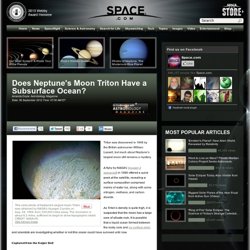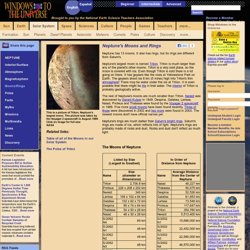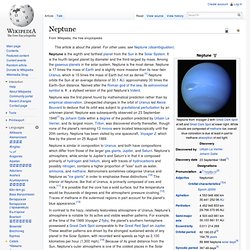

Visting neptune. The Moons of Neptune. The Moons of Neptune Neptune has two large moons that are easily seen from Earth, Triton and Nereid.

Voyager 2 discovered six additional moons. One of these is actually larger than Nereid, but could not be seen easily from Earth because it orbits close to Neptune. Triton. Neptune moons. Moons in our solar system: Moons of Neptune. Does Neptune's Moon Triton Have a Subsurface Ocean? Triton was discovered in 1846 by the British astronomer William Lassell, but much about Neptune’s largest moon still remains a mystery.

A flyby by NASA's Voyager 2 spacecraft in 1989 offered a quick peek at the satellite, revealing a surface composition comprised mainly of water ice, along with some nitrogen, methane, and carbon dioxide. As Triton’s density is quite high, it is suspected that the moon has a large core of silicate rock. It is possible that a liquid ocean formed between the rocky core and icy surface shell , and scientists are investigating whether or not this ocean could have survived until now. Captured from the Kuiper Belt Triton, which is about 1,680 miles (2,700 kilometers) wide, has a unique property among large solar system moons: a retrograde orbit. [ Video: Fly By Neptune's Freezing Moon Triton ] Planets form from a circumstellar disc of dust and gas that surrounds a young star.
Heating the interior said Saswata Hier-Majumder at the University of Maryland. All About Planet Neptune for Kids « Blue. Neptune Moons and Rings. This is a picture of Triton, Neptune's largest moon.

The picture was taken by the Voyager 2 spacecraft in August 1989. Click on image for full size NASA. Neptune - Astronomy Games For Kids. Neptune's Moons. Moons. Neptune: Moons. We don't know with what beverage William Lassell may have celebrated his discovery of Neptune's moon, Triton, but beer made it possible.

Lassell was one of 19th century England's grand amateur astronomers, using the fortune he made in the brewery business to finance his telescopes. He spotted Triton on 10 October 1846 -- just 17 days after a Berlin observatory discovered Neptune. Curiously, a week before he found the satellite, Lassell thought he saw a ring around the planet. Neptune. Neptune. Neptune is similar in composition to Uranus, and both have compositions which differ from those of the larger gas giants, Jupiter, and Saturn.

Neptune's atmosphere, while similar to Jupiter's and Saturn's in that it is composed primarily of hydrogen and helium, along with traces of hydrocarbons and possibly nitrogen, contains a higher proportion of "ices" such as water, ammonia, and methane. Astronomers sometimes categorise Uranus and Neptune as "ice giants" in order to emphasise these distinctions.[10] The interior of Neptune, like that of Uranus, is primarily composed of ices and rock.[11] It is possible that the core has a solid surface, but the temperature would be thousands of degrees and the atmospheric pressure crushing.[12] Traces of methane in the outermost regions in part account for the planet's blue appearance.[13] In contrast to the hazy, relatively featureless atmosphere of Uranus, Neptune's atmosphere is notable for its active and visible weather patterns.
Neptune - Ancient Roman Gods for Kids. Moons of Neptune. Discovery and naming[edit] Discovery[edit] On July 15, 2013, a team of astronomers led by Mark Showalter of the SETI Institute revealed to Sky & Telescope magazine that they had discovered a previously unknown fourteenth moon in images taken by the Hubble Space Telescope from 2004–2009.

The unnamed fourteenth moon, currently identified as S/2004 N 1, is thought to measure no more than 16–20 km in diameter.[7] Names[edit] Two asteroids share the same names as moons of Neptune: 74 Galatea and 1162 Larissa. Characteristics[edit] The moons of Neptune can be divided into two groups: regular and irregular. Animated three-dimensional model of Proteus Regular moons[edit] All of Neptune's inner moons are dark objects: their geometrical albedo ranges from 7 to 10%.[16] Their spectra indicate that they are made from water ice contaminated by some very dark material, probably complex organic compounds. Cool imformathon. Neptune. Neptune diameter. Neptune. Neptune means: At first, Neptune was only the god of water, but later on this was extended to include the sea when he became associated with the Greek god Poseidon.

How much would you weigh on Neptune? If you weigh 70 pounds (32 kg) on the Earth, you would weigh 78.5 pounds (36 kg) on Neptune. The Planet For many, centuries people did not know that this planet even existed. It was discovered by Johann Galle and Heinrich D'Arrest in 1846. Neptune is the smallest of the four gas giants in our Solar System. Not much was known about Neptune until it was visited by the spacecraft Voyager 2 on August 25, 1989.
In Neptune's atmosphere, there is a large white cloud that moves around rather quickly. When Voyager 2 visited Neptune, its pictures showed a giant storm much like the storm on Jupiter. Neptune is a very windy place. Rings Neptune has six rings which circle the planet.